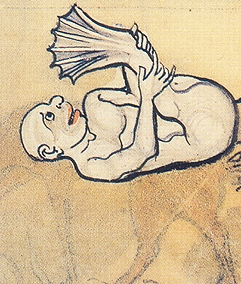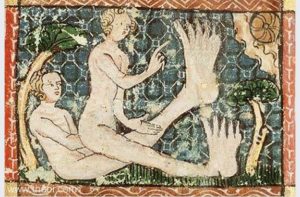From the Itinerarius (Vol.3) of Philip the Pedant:
There is much misinformation about the people known as sciopods, skiapodes, monoscelans, monocoli, or, to the vulgar, monopods. They are seldom encountered outside of the hot countries, and appear relatively uncommon within them. Many assume them to be a myth or traveller’s tale. Sometimes attested to be a form of dwarf, they are have a closer resemblance to small men, but some dwarven features are evident in many.
Pliny the Eldar, St Augustine and others correctly report “…another race of men, who have only one leg but are able to leap with surprising agility. The same people are also called Skiapodae, because they are in the habit of lying on their backs, during the time of the extreme heat, and protect themselves from the sun by the shade of their feet.” This will give the reader some idea of the size of a sciopod’s foot.

One error is that their foot is webbed. This may have arisen from the theory that the sciopods are a tribe of merman that has taken to living on the land. Since sciopods are well known for their habit of shading themselves from the sun with their foot, it may have been deduced that a webbed foot was better suited for such a purpose.
A more common error is to draw the sciopod with either a left or right foot. Indeed, it is difficult to find a woodcut that shews them correctly. As the many travellers who have encountered them will confirm, the middle toe of the sciopod is the largest, with the two neighbouring toes of smaller, but equal size to each other, and the outermost toes the most diminutive of all. This form explains St Augustine’s statement that the “skiopodes are a race who have two feet but only one leg”. The nails of the foot, particularly of the central three toes, are very thick, that of the middle-most resembling a hoof. When the sciopod moves at great speed, only the tip of the middle toe contacts the earth, and it is proportioned and constructed to accommodate such stresses and wear.

While the sciopod uses its foot for shade, the sun tans the sole of the foot into tough, dark leather, muchly darker than the sciopod’s other skin. Many chroniclers have described the great speed and agility of the sciopods. The sciopod’s powerful leg allows it to move as swift as a horse and rider, rivalling a gazelle. The toughened sole and thick nails protect the foot when moving across rough terrain.
It has been incorrectly reported that the sciopods are non-violent vegetarians and do not even kill plants, but live by inhaling the scent of a plant they carry with them. Sciopods exist on the same diet that sustains other men. Some are known to carry certain plants and appear to savour their odours as a narcotic or stimulant. These seem to have no effect on normal men.
For war and hunting the sciopods favour the spear and the bow. The Norse explorer Karlsefni reports his companion Thorvald died from an arrow-wound given to him by a sciopod, which then escaped swiftly across rough ground. If a sciopod has thrown his spear or expended his arrows he may use his great speed, powerful leg and hardened foot to deliver a powerful kick that may down an armoured man or break through a wall. They have been known to kick trees to dislodge coconuts, and sometimes tree-dwelling animals or their nests.
Many scholars have speculated on the final topic. The privy parts of a sciopod are located on the rear-side of the leg. Both sexes have a vent, like that of a serpent or shark, in which their parts are protected when not used. Some older readers will fondly recall the several sciopodesses that briefly were available in some of the bawdy houses of Southvarke. When coupling, a pair of sciopods have a number of options. Most commonly they lay with their legs raised and pressed together, allowing them to enjoy the shade as well as each other. 
